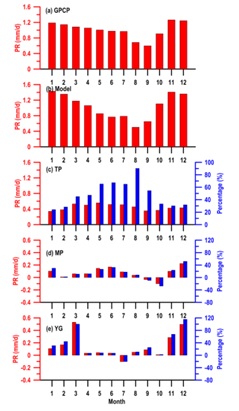
As the "Third Pole" of the world, Tibetan Plateau (TP) has played an essential role in the evolution and strengthening of coupled climate system of Asian monsoon and inland arid climate since the Cenozoic. Numerical simulation on climate effects of TP has always been one of the key research directions in the field of Earth sciences.
In recent years, a growing number of studies have found that regional and relatively smaller scale topography also has significant impact on Asian climate, indicating that studies on the climate effects of TP cannot only focus on the main body of the plateau itself.
Recently, Dr. SHI Zhengguo and his colleagues from the Institute of Earth Environment (IEE) of the Chinese Academy of Sciences analyzed the effect of the main TP and its surrounding topography on the evolution of Asian climate through high resolution atmospheric circulation model.
The surrounding topography included the Yunnan-Guizhou Plateau at the southeastern margin of TP, the Pamir Plateau and Tian Shan Mountains at the northern margin and the Mongolian Plateau further north.
Different from the strengthening effect of the main body of TP, the Yunnan-Guizhou Plateau significantly weakened the Indian monsoon. With the uplift of the Yunnan-Guizhou Plateau, an anomalous anticyclonic circulation appeared in the lower troposphere over the southwest, resulting in the weakening of monsoon circulation from the Bay of Bengal to the Indian subcontinent and the Arabian Sea. The decline in Indian monsoon precipitation caused by the Yunnan-Guizhou Plateau accounted for one-third of the total increase in precipitation caused by the entire TP.
For the arid interior Asia, the main TP, Yunnan-Guizhou Plateau, Pamir Plateau and Tian Shan Mountains, as well as the Mongolian Plateau all have reduced the annual precipitation in some extent.
However, different from the consistent inhibiting effect of the main TP on the precipitation throughout the year, the decreasing effect of the Yunnan-Guizhou Plateau and the Mongolian Plateau was mainly effective in boreal winter (Fig. 1), which was closely related to the mechanical blocking effect.
In addition, the Pamir Plateau and Tian Shan Mountains, located at the northern margin of the main TP, played a key role in the temporal and spatial differentiation of precipitation over the arid interior Asia (Fig. 2).
Before the appearance of the Pamir and Tian Shan, the precipitation seasonality over the eastern sub-region was consistent with that over the western sub-region, with maximum rainfall in spring and winter and minimum rainfall in summer.
With the uplift of Pamir and Tian Shan, the precipitation over the eastern sub-region decreased in winter and significantly increased in summer, which led to the alteration of precipitation seasonality to summer dominated. The precipitation seasonality over the north of Tian Shan Mountains also changed during the uplift.
The above results indicated that different part of the extensive-"Third Pole" had different influences on the Asian monsoon and inland arid climate. It suggested that the Asian monsoon–inland arid climate may have undergone complex evolutionary processes on tectonic scale. The study was published in Journal of Climate and Climate Dynamics.

Fig.1 Response of monthly precipitation rates (mm/day) over the arid interior Asia: (a) GPCP observation; (b) TP1 run; (c) TP0-TP1; (d) MP0-TP1; (e) YG-TP1. (Imaged by SHI, et al)

Fig.2 Winter-dominant precipitation regions (green dots) in the three experiments: (a) Control run, (b) mvTS-Pr run, and (c) mvTP run. The black contours show the precipitation difference between summer and winter. The areas higher than 1500 m are shaded in gray. (Image by SHI, et al)

86-10-68597521 (day)
86-10-68597289 (night)

52 Sanlihe Rd., Xicheng District,
Beijing, China (100864)

